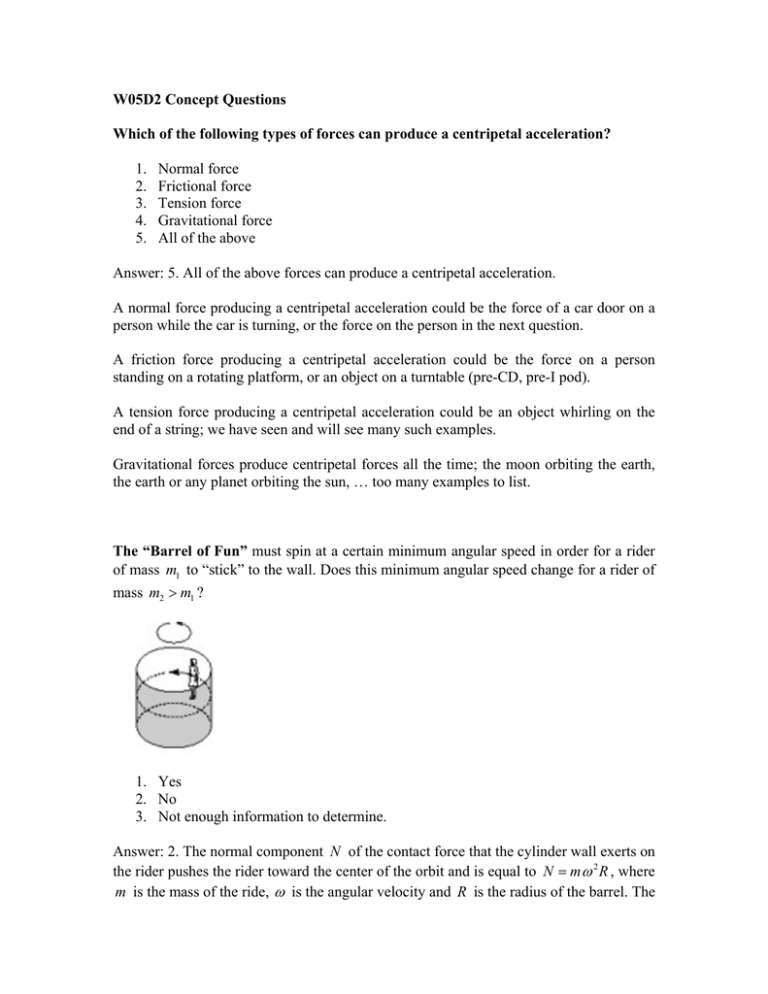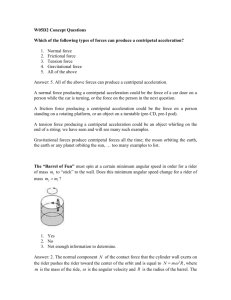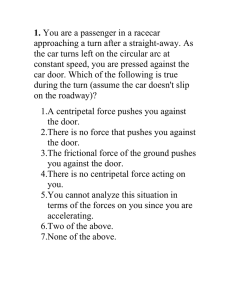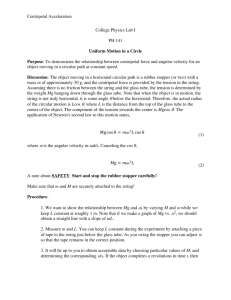W05D2 Concept Questions Which of the following types of
advertisement

W05D2 Concept Questions Which of the following types of forces can produce a centripetal acceleration? 1. 2. 3. 4. 5. Normal force Frictional force Tension force Gravitational force All of the above Answer: 5. All of the above forces can produce a centripetal acceleration. A normal force producing a centripetal acceleration could be the force of a car door on a person while the car is turning, or the force on the person in the next question. A friction force producing a centripetal acceleration could be the force on a person standing on a rotating platform, or an object on a turntable (pre-CD, pre-I pod). A tension force producing a centripetal acceleration could be an object whirling on the end of a string; we have seen and will see many such examples. Gravitational forces produce centripetal forces all the time; the moon orbiting the earth, the earth or any planet orbiting the sun, … too many examples to list. The “Barrel of Fun” must spin at a certain minimum angular speed in order for a rider of mass m1 to “stick” to the wall. Does this minimum angular speed change for a rider of mass m2 > m1 ? 1. Yes 2. No 3. Not enough information to determine. Answer: 2. The normal component N of the contact force that the cylinder wall exerts on the rider pushes the rider toward the center of the orbit and is equal to N = m ω 2 R , where m is the mass of the ride, ω is the angular velocity and R is the radius of the barrel. The vertical component of the contact force (static friction) supports the rider and hence is equal to its maximum value, fs = mg . The normal force must be large enough in magnitude to result in this frictional force, μs N = μs m ω 2 R > mg , or ω > g / Rμs , independent of the mass of the rider. Note that in the limit μs → 0 , the necessary angular speed becomes unboundedly large. A stone attached to a string is whirled in a vertical plane. Let T1 , T2 , T3 and T4 be the tensions at locations 1, 2, 3, and 4 required for the stone to have a given speed v0 at these four locations. What are the relative tensions in the string? 1. 2. 3. 4. T3 > T2 > T1 = T4 T1 = T2 = T3 = T4 T1 > T2 = T4 > T3 None of the above Answer: 3. When the string is in positions 2 and 4, the tension force is directed radially inward and the tension is equal to T2 = T4 = m v0 2 / R , where m is the mass of the stone and R is the radius of the circle. When the string is in position 3 the tension and the gravitational force points downward (inward), hence T3 + mg = mv0 2 / R and thus T3 = mv0 2 / R − mg < T2 = T4 . When the string is in position 1, the tension points upward and the gravitational force points downward (outward), hence T3 − mg = mv0 2 / R and thus T3 = mv0 2 / R + mg > T2 = T4 . A puck of mass M is moving in a circle at uniform speed on a frictionless table as shown below. The puck is attached to a massless, frictionless string that passes through a hole in the table and which is in turn attached to a suspended bob, also of mass M , at rest below the table. What is the magnitude of the centripetal acceleration of the moving puck? 1. 2. 3. 4. 5. Less than g Equal to g Greater than g Zero Insufficient information Answer: 2. Since the suspended bob is static, the tension in string is equal to the gravitational force acting on the bob, T = Mg . The puck is accelerating inward due to the tensile force of the string acting on the puck, hence T = Ma . Thus Mg = Ma , or g = a .



